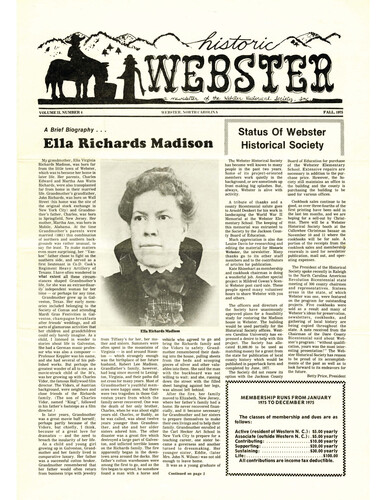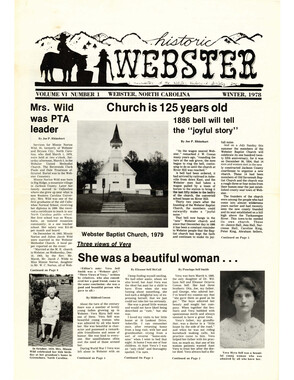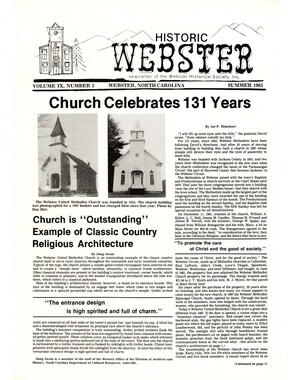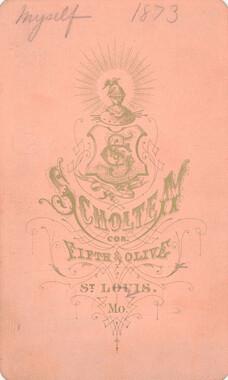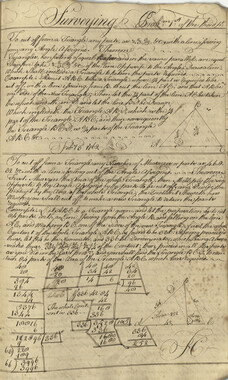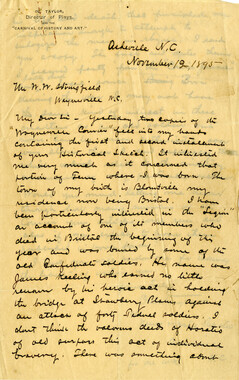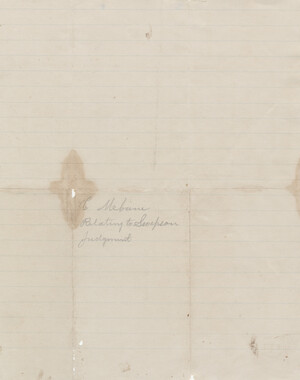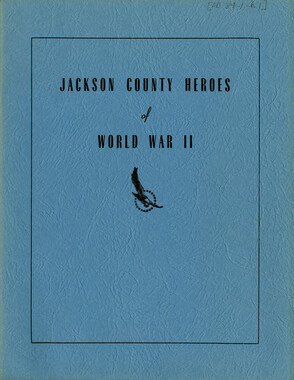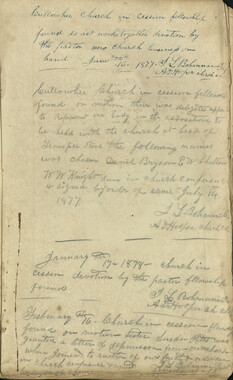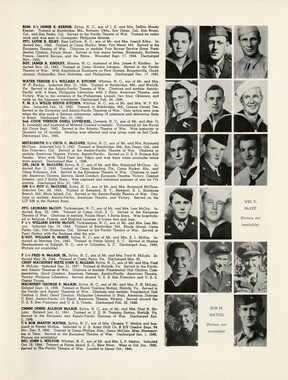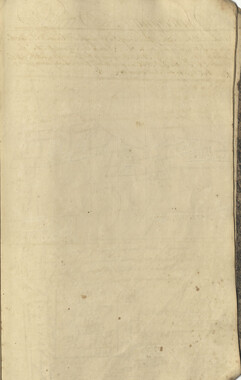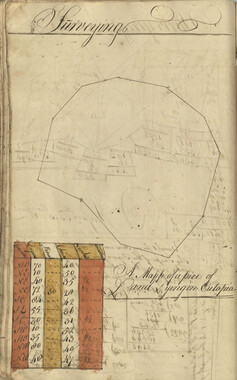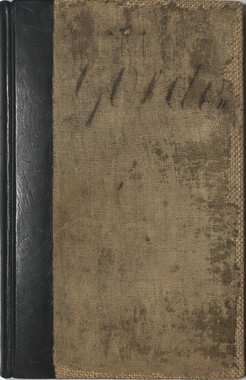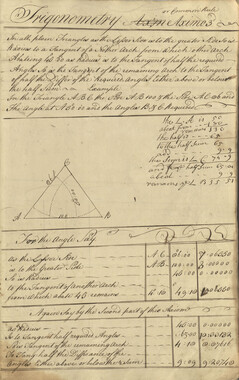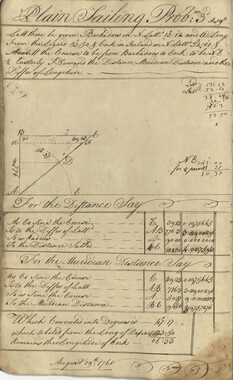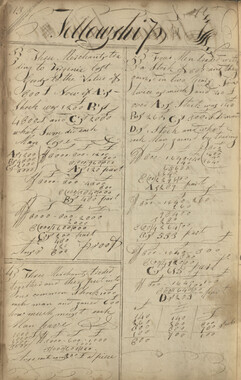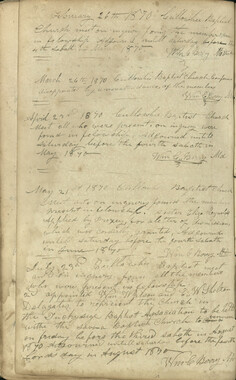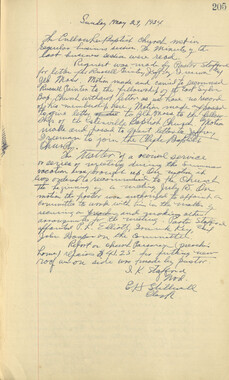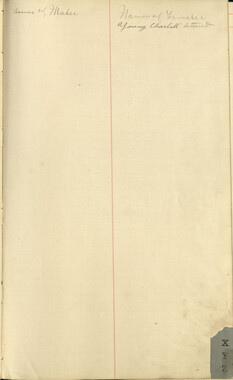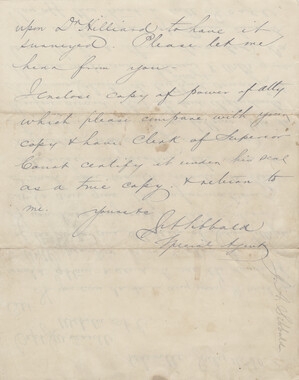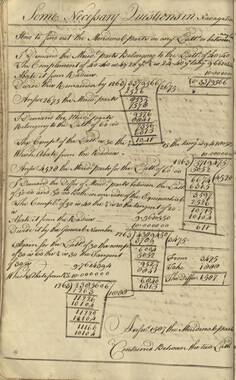Western Carolina University (20)
View all
- Canton Champion Fibre Company (2308)
- Cherokee Traditions (292)
- Civil War in Southern Appalachia (165)
- Craft Revival (1942)
- Great Smoky Mountains - A Park for America (2766)
- Highlights from Western Carolina University (430)
- Horace Kephart (941)
- Journeys Through Jackson (154)
- LGBTQIA+ Archive of Jackson County (85)
- Oral Histories of Western North Carolina (314)
- Picturing Appalachia (6772)
- Stories of Mountain Folk (413)
- Travel Western North Carolina (160)
- Western Carolina University Fine Art Museum Vitreograph Collection (129)
- Western Carolina University Herbarium (92)
- Western Carolina University: Making Memories (708)
- Western Carolina University Publications (2283)
- Western Carolina University Restricted Electronic Theses and Dissertations (146)
- Western North Carolina Regional Maps (71)
- World War II in Southern Appalachia (131)
University of North Carolina Asheville (6)
View all
- Carver, George Washington, 1864?-1943 (26)
- Masa, George, 1881-1933 (8)
- Niggli, Josephina, 1910-1983 (10)
- Whitman, Walt, 1819-1892 (10)
- Wilburn, Hiram Coleman, 1880-1967 (1)
- Allanstand Cottage Industries (0)
- Appalachian National Park Association (0)
- Bennett, Kelly, 1890-1974 (0)
- Berry, Walter (0)
- Brasstown Carvers (0)
- Cain, Doreyl Ammons (0)
- Cathey, Joseph, 1803-1874 (0)
- Champion Fibre Company (0)
- Champion Paper and Fibre Company (0)
- Cherokee Indian Fair Association (0)
- Cherokee Language Program (0)
- Crittenden, Lorraine (0)
- Crowe, Amanda (0)
- Edmonston, Thomas Benton, 1842-1907 (0)
- Ensley, A. L. (Abraham Lincoln), 1865-1948 (0)
- Fromer, Irving Rhodes, 1913-1994 (0)
- George Butz (BFS 1907) (0)
- Goodrich, Frances Louisa (0)
- Grant, George Alexander, 1891-1964 (0)
- Heard, Marian Gladys (0)
- Kephart, Calvin, 1883-1969 (0)
- Kephart, Horace, 1862-1931 (0)
- Kephart, Laura, 1862-1954 (0)
- Laney, Gideon Thomas, 1889-1976 (0)
- McElhinney, William Julian, 1896-1953 (0)
- North Carolina Park Commission (0)
- Osborne, Kezia Stradley (0)
- Owens, Samuel Robert, 1918-1995 (0)
- Penland Weavers and Potters (0)
- Rhodes, Judy (0)
- Roberts, Vivienne (0)
- Roth, Albert, 1890-1974 (0)
- Schenck, Carl Alwin, 1868-1955 (0)
- Sherrill's Photography Studio (0)
- Smith, Edward Clark (0)
- Southern Highland Handicraft Guild (0)
- Southern Highlanders, Inc. (0)
- Stalcup, Jesse Bryson (0)
- Stearns, I. K. (0)
- Thompson, James Edward, 1880-1976 (0)
- United States. Indian Arts and Crafts Board (0)
- USFS (0)
- Vance, Zebulon Baird, 1830-1894 (0)
- Weaver, Zebulon, 1872-1948 (0)
- Western Carolina College (0)
- Western Carolina Teachers College (0)
- Western Carolina University (0)
- Western Carolina University. Mountain Heritage Center (0)
- Williams, Isadora (0)
- 1700s (2)
- 1800s (13)
- 1820s (2)
- 1830s (2)
- 1840s (2)
- 1850s (4)
- 1860s (16)
- 1870s (9)
- 1880s (29)
- 1890s (9)
- 1900s (20)
- 1910s (23)
- 1920s (36)
- 1930s (38)
- 1940s (35)
- 1950s (46)
- 1960s (8)
- 1970s (27)
- 1980s (16)
- 1990s (1)
- 2000s (8)
- 1600s (0)
- 1810s (0)
- 2010s (0)
- 2020s (0)
- Appalachian Region, Southern (5)
- Buncombe County (N.C.) (10)
- Cherokee County (N.C.) (8)
- Graham County (N.C.) (11)
- Haywood County (N.C.) (9)
- Jackson County (N.C.) (151)
- Macon County (N.C.) (32)
- Madison County (N.C.) (1)
- McDowell County (N.C.) (2)
- Swain County (N.C.) (7)
- Asheville (N.C.) (0)
- Avery County (N.C.) (0)
- Blount County (Tenn.) (0)
- Clay County (N.C.) (0)
- Great Smoky Mountains National Park (N.C. and Tenn.) (0)
- Henderson County (N.C.) (0)
- Knox County (Tenn.) (0)
- Knoxville (Tenn.) (0)
- Lake Santeetlah (N.C.) (0)
- Mitchell County (N.C.) (0)
- Polk County (N.C.) (0)
- Qualla Boundary (0)
- Rutherford County (N.C.) (0)
- Transylvania County (N.C.) (0)
- Watauga County (N.C.) (0)
- Waynesville (N.C.) (0)
- Yancey County (N.C.) (0)
- Artifacts (object Genre) (3)
- Cards (information Artifacts) (2)
- Clippings (information Artifacts) (4)
- Drawings (visual Works) (1)
- Envelopes (23)
- Fiction (general Genre) (1)
- Letters (correspondence) (120)
- Manuscripts (documents) (11)
- Memorandums (9)
- Minutes (administrative Records) (2)
- Newsletters (39)
- Periodicals (39)
- Photographs (222)
- Portraits (173)
- Postcards (10)
- Publications (documents) (7)
- Speeches (documents) (1)
- Tintypes (photographs) (1)
- Aerial Photographs (0)
- Aerial Views (0)
- Albums (books) (0)
- Articles (0)
- Bibliographies (0)
- Biography (general Genre) (0)
- Crafts (art Genres) (0)
- Depictions (visual Works) (0)
- Design Drawings (0)
- Facsimiles (reproductions) (0)
- Financial Records (0)
- Fliers (printed Matter) (0)
- Glass Plate Negatives (0)
- Guidebooks (0)
- Internegatives (0)
- Interviews (0)
- Land Surveys (0)
- Maps (documents) (0)
- Negatives (photographs) (0)
- Newspapers (0)
- Occupation Currency (0)
- Paintings (visual Works) (0)
- Pen And Ink Drawings (0)
- Personal Narratives (0)
- Plans (maps) (0)
- Poetry (0)
- Programs (documents) (0)
- Questionnaires (0)
- Scrapbooks (0)
- Sheet Music (0)
- Slides (photographs) (0)
- Songs (musical Compositions) (0)
- Sound Recordings (0)
- Specimens (0)
- Text Messages (0)
- Transcripts (0)
- Video Recordings (physical Artifacts) (0)
- Vitreographs (0)
- C.W. Slagle Collection (4)
- Sara Madison Collection (144)
- A.L. Ensley Collection (0)
- Appalachian Industrial School Records (0)
- Appalachian National Park Association Records (0)
- Axley-Meroney Collection (0)
- Bayard Wootten Photograph Collection (0)
- Bethel Rural Community Organization Collection (0)
- Blumer Collection (0)
- Canton Area Historical Museum (0)
- Carlos C. Campbell Collection (0)
- Cataloochee History Project (0)
- Cherokee Studies Collection (0)
- Daisy Dame Photograph Album (0)
- Daniel Boone VI Collection (0)
- Doris Ulmann Photograph Collection (0)
- Elizabeth H. Lasley Collection (0)
- Elizabeth Woolworth Szold Fleharty Collection (0)
- Frank Fry Collection (0)
- George Masa Collection (0)
- Gideon Laney Collection (0)
- Hazel Scarborough Collection (0)
- Hiram C. Wilburn Papers (0)
- Historic Photographs Collection (0)
- Horace Kephart Collection (0)
- Humbard Collection (0)
- Hunter and Weaver Families Collection (0)
- I. D. Blumenthal Collection (0)
- Isadora Williams Collection (0)
- Jesse Bryson Stalcup Collection (0)
- Jim Thompson Collection (0)
- John B. Battle Collection (0)
- John C. Campbell Folk School Records (0)
- John Parris Collection (0)
- Judaculla Rock project (0)
- Kelly Bennett Collection (0)
- Love Family Papers (0)
- Major Wiley Parris Civil War Letters (0)
- Map Collection (0)
- McFee-Misemer Civil War Letters (0)
- Mountain Heritage Center Collection (0)
- Norburn - Robertson - Thomson Families Collection (0)
- Pauline Hood Collection (0)
- Pre-Guild Collection (0)
- Qualla Arts and Crafts Mutual Collection (0)
- R.A. Romanes Collection (0)
- Rosser H. Taylor Collection (0)
- Samuel Robert Owens Collection (0)
- Sherrill Studio Photo Collection (0)
- Smoky Mountains Hiking Club Collection (0)
- Stories of Mountain Folk - Radio Programs (0)
- The Reporter, Western Carolina University (0)
- Venoy and Elizabeth Reed Collection (0)
- WCU Gender and Sexuality Oral History Project (0)
- WCU Mountain Heritage Center Oral Histories (0)
- WCU Oral History Collection - Mountain People, Mountain Lives (0)
- WCU Students Newspapers Collection (0)
- Western North Carolina Tomorrow Black Oral History Project (0)
- William Williams Stringfield Collection (0)
- Zebulon Weaver Collection (0)
- Church buildings (1)
- Dance (1)
- Education (13)
- Floods (3)
- Forced removal, 1813-1903 (1)
- World War, 1939-1945 (1)
- African Americans (0)
- Appalachian Trail (0)
- Artisans (0)
- Cherokee art (0)
- Cherokee artists -- North Carolina (0)
- Cherokee language (0)
- Cherokee pottery (0)
- Cherokee women (0)
- Civilian Conservation Corps (U.S.) (0)
- College student newspapers and periodicals (0)
- Dams (0)
- Folk music (0)
- Forest conservation (0)
- Forests and forestry (0)
- Gender nonconformity (0)
- Great Smoky Mountains National Park (N.C. and Tenn.) (0)
- Hunting (0)
- Landscape photography (0)
- Logging (0)
- Maps (0)
- Mines and mineral resources (0)
- North Carolina -- Maps (0)
- Paper industry (0)
- Postcards (0)
- Pottery (0)
- Railroad trains (0)
- Rural electrification -- North Carolina, Western (0)
- School integration -- Southern States (0)
- Segregation -- North Carolina, Western (0)
- Slavery (0)
- Sports (0)
- Storytelling (0)
- Waterfalls -- Great Smoky Mountains (N.C. and Tenn.) (0)
- Weaving -- Appalachian Region, Southern (0)
- Wood-carving -- Appalachian Region, Southern (0)
- StillImage (230)
- Text (200)
- MovingImage (0)
- Sound (0)
Historic Webster Vol. 2 No. 4
-
Historic Webster is a newsletter of the Webster Historical Society, Inc., created at the Society’s founding in 1974. The publication helped to serve the Society's mission of collecting and preserving the history of Webster, North Carolina. Webster, established in 1851, was the original county seat for Jackson County.
-
-
A Brief Biography ... Ella Ri~hards Mad ison My grandmother, Ella Virginia Richards Madison, was born far from the little town of Webster, which was to become her home in later life. Her parents, Charles Edward and Martha Ann Watts Richards, were also transplanted far from home in their married life. Grandmother's grandfather, John Richards , was born on Wall Street (his home was the site of the original stock exchange in New York City) and Grandmother's father , Charles, was born in Springfield , New Jersey . Her mother, Martha Ann, was born in Mobile, Alabama. At the time Grandmother's parents were married ( 1861 ) this combination of northern and southern backgrounds was rather unusual , to say the least. To make matters even more surprising, her " Yankee" father chose to fight on the southern side, and served as a first lieutenant in Co.D. Cook's Regiment Heavy Arti llery of Texans. I have often wondered to what extent all these circumstances shaped Grandmother's life, for she was an extraordinari l y~ independent woman for her lime- or perhaps for any time. Grandmother grew up in Galveston, Texas. Her early memories included belonging to the Society of Comus and attending Mardi Gras Festivities in Galvesto n, champagne breakfasts after fr iends' weddings, and all sorts of glamorous activities that her children and grandchildren could only barely imagine. As a child, I listened in wonder to stories about life in Galveston , She had a German music professor who was also a composer - Professor Keppler was his name, and she had several of his published works. But perhaps the greatest wonder of all to me, as a movie-struck child of the 30's, was her growing up with Charles Vidor , the famous Hollywood film director. The Vidors, of Austrian background, were neighbors and close friends of the Richards fam il y. (The son of Charles Vidor, named " King", followed in his father's footsteps as a film director.) In later years, Grandmother was a great movie buff herself; perhaps partly because of the Victors, but chiefly, I think, because of a great love for dramatics - and the need to breach the insularity of her life. As a child and young girl growing up in Galveston, Grandmother and her family lived in comparative luxury. Her father was a successful cotton broker. Grandmother remembered that her father would often return from business trips with jewelry Ella Richards Madison from Tiffany 's for her, her mother and s isters. Summers were often spent in the mountains of Virginia - in and around Staunton - which strangely enough was the birthplace of her future husband, Robert Lee Madison. Grandfather's family, however, had long since moved to Lexington, Virginia, and their paths did not cross for many years. Most of Grandmother's youthful memories were happy ones, but there were two tragedies in those Galveston years from which the fami1y never recovered. One was the death of her only brother, Charles, when he was about eight years old. Charles, or Buddy, as he was called, was about twelve years younger than Grandmother, and she and her older sisters adored him. The other disaster was a great fire which destroyed a large part of Galveston, and inflicted terrible losses on the Richards family. The fire apparently began in the downtown area around the docks . Her father 's cotton warehouses were among the first to go, and as the fire began to spread, he somehow found a man with a horse and vehicle who agreed to go and bring the Richards family and the Victors to safety. Grandmother remembered their dashing into the house, pulling sheets from the beds and scooping pieces of silver and other valuables into them. She said the man with the buckboard was not willing to wait; and she, running down the street with the filled sheet banging against her legs, was almost left behind. After the fire, her family moved to Elizabeth, New Jersey, where her father 's family had a home. He never recovered financially, and it became necessary for Grandmother and her sisters to prepare themselves to make their own livings and to help their family. Grandmother enrolled at the Carl Hecker Art School in New York City to prepare for a teaching career, one sister became a governess and another turned to dressmaking. Her younger sister, Eddie, (later Mrs. John N. Wilson) was not old enough to leave home. It was as a young graduate of Continued on page 2 The Webster Historical Society has become well known to many people in the past two years. Some of its project-oriented members work quietly in the background, or are sometim~s up front making big splashes. But, ·always , Webster is alive with activity. A tribute of thanks and a county Bicentennial salute goes to Arnold Denkert for his work in landscaping the World War II Memorial at the Webster Elementary School. The keeping of this memorial was entrusted to the Society by the Jackson County Board of Education. Much appreciation is also due Louise Davis for researching and editing the material for Histor ic Webster, the newsletter. Many thanks go to its other staff members and to the contributors of articles for publication. Kate Rhinehart as membership and cookbook chairman is doing a wonderful job. Another special project is Mildred Cowan's Scenic Webster post card sale. These people spend many volunteer hours to share Webster with you and others. Board of Education for purchase of the Webster Elementary School. Extensive repairs a re necessary in addition to the purchase price. However, the So. ciety still maintains an office in the building and the county is purchasing the building to be used for various offices. Cookbook sales continue to be good, as over thr ee-fourths of the· first printing have been sold in the last ten months, and we are hoping for a sell-out by Christmas. There will be a Webster Historical Society booth at the Cullowhee Christmas bazaar on November 10 and 11 where the cookbooks will be for sale. A portion of the receipts from the cookbook sales and membership renewal~ is used for newsletter publication, mail out, and operating expenses. The President of the Historical Society spoke recently in Raleigh to the North Carolina American Revolution Bicentennial state meeting of 300 county cha irmen and representatives. Sixteen areas in the state, of which Webster was one, were featured on the program for outstanding The officers and directors of projects. Five cookbooks were the Society have unanimously sold as a result and many of approved plans for a feasibility · Webster's ideas for preservation, study for restoring the Madison newsletters, cookbooks , a nd house in Webster. The building gathering of local history are would be used partially for the bei ng copied thro ughout the Historical Society offices. West- state. A note received from the ern Carolina University has ex- Chairman of the Dare County pressed a desire to help with this Bicentennial said about Webproject. The Society has allo- ster's program: " without qualificated $1,000.00 to be used as cation, yours was the most intermatching money for a grant from esting presentation !" The Webthe state for publication of local ster Historical Society has reason county history which would be to be proud of its accomplishpublished in paperback form and ments of the past as well as to completed by June, 1977. look forwa rd to its endeavors for The Society did not renew its the future. option with the Jackson County Betty Pr ice, President IVo"o"o"o"o"o"•"•"•"o"•"•"o"•"•"•""'•"•""'"'"'•"•"o"o"o"•""'•"•"•V.t'o"o"oVo"o"o'Yo".t'o MEMBERSHIP RUNS FROM JANUARY 1975 TO DECEMBER 1975 The classes of membership and dues are as follows : Active (resident of Western N. C.J : $5.00 yearly Associate (outside Western N. C.): . $5.00 yearly Contributing : . . .................. $10.00 yearly Supporting : ...... _ ... _ ... _ .. ... .. $20.00 yearly Sustaining: ...................... $30.00 yearly Life: ................... ... . . ..... ...... $100.00 All contributions are income tax deductible. Historic Webster, Fall 1975, Page 2 Ella R. Madison, cont. music and art school that Grandmother heard of an opening for a teacher of fine arts in North Carolina. Her cousin, Louise Hobby, of Beaumont, Texas, was a student at St. Mary's in Raleigh, where she became a good friend of the daughters of Judge D. D. Davies of Cullowhee. While visiting in the Davies home at Forest Hill , Louise met Grandfather and hearing of his need for a teacher, told him of her cousin in New York. Grandfather wrote Grandmother and presented his case so well that she decided to come to Cullowhee. She came alone, boarded with the Davies f~mily, and began a career in the new fine arts department at what was then Cullowhee High School. She taught violin, voice , dramatics , penmanship, piano, and art. Stepping out into the unknown like this , alone and far from home, certainlY required a lot of courage, but courage was a quality she never lacked. Grandmother was one of the strongest women I've ever known. By the beginning of her second year of teaching, she and Grandfather were planning to be married - of course it would have to be during a school vacation - so the Thanksgiving season was chosen. They were married in November, 1891 at St. David's Episcopal Church in Cullowhee. Their friends , Cora Davies and Thomas Cox were the first couple to be married in that church, and Grandmother and Grandfather were the second. They went on a short honeymoon trip to the North Carolina coast, and then began housekeeping in a rented house in Cullowhee. They had very little furniture to put in a house , but improvised well. Wooden orange crates with little curtains served as cabinets and cupboards, and Grandmother entertained guests at a dining room table made of crates, with a wooden cheese-box top. With her prettiest linens and silver, who could tell the difference? Within a few years they were able to buy land a few miles from the present campus and build their own home on sixty-six acres in what was known as Painter, N. C. Their house , built on a hill overlooking. the Tuckaseigee River , was named "Oak Knoll " . Their first child, Robert Edward was born before the house was built, but James Ambrose, Monro Bolling, Annie Louise , William Haight and John Banister (my father) were all born at Oak Knoll in Painter (now Cullowhee). Grandmother 's parents and sister, Eddie, moved to Cullowhee from New Jersey in about 1897. For a few years they lived with Grandmothec and Grandfather at Oak Knoll, and then built a house in Cullowhee. During the busy years while the family was growing, Grandmother had the help of " Aunt" Amanda Casey, so she was able to continue teaching. Even on occasion she and Grandfather would board one or two students. Taking care of all the students who wanted to attend the struggling young school was a community concern in Cullowhee. I was once told by one of the women who boarded there as a young girl (Mrs. C. Z. Candler), that it was a sight to see Grll!ldmother rushing about the house in the mornings getting ready for school, and then flying off down the hill in the horse and buggy. Grandfather always went earlier on horseback. Somehow, during those busy years ( 1903-1905) Grandmother found time to paint a life-size oil portrait of Grandfather. It was commissioned by the Columbian Literary Society to be presented to the school. A little ceremony was planned for the presentation, and Aunt Louise and Uncle Jim were to draw the cord to unveil the portrait. At the last minute, Aunt Louise became panic-stricken and dug in her heels, refusing to move. Grandmother, still trying to preserve the dignity of the occasion , gathered up another little girl, Davie Coward, who happily 'went forward with Uncle Jim. The whole life of the family was bound up with the life of the school, and when a need existed there, it was natural to try to fill it. So it happened that in about 1910, a new girls ' dormitory , Davies Hall , had been opened, but there was no one to look after it. Grandmother and Grandfather agreed to move their family into the dormitory until someone could be found. They, of course, left most of their furniture and personal belongings behind in their home. Moving a family of eight was cumbersome enough. One night , after several months of living in Davies Hall, Grandmother awakened suddenly and heard someone say "Ella." She saw Grandfather sleeping quietly beside here, and then she heard her name called again, " Ella." That was all she heard and finally she went back to sleep. The next morning she learned that their home had burned to the ground. Fire, for the second time, had completely altered her life. The family remained in Cullowhee for several years, living in rented houses, and then moved to Webster. In Webster , after three years , they bought the house previously owned by Mrs. Sophia Coward and operated as a boarding house. As long as Webster was the county seat and court was held there, there had been a need for boarding houses , but court was being held in the new county seat of Sylva and Webster began to decline. But it was to be my grandparents ' last home. It was in Webster that Grandmother suffered a serious accident
r brother and sister he had never met, children born to Juana after she and Philip left Burgundy for Castile. Carlos and his younger brother Fernando became firm friends in spite of various court factions' efforts to drive them apart, while their little sister, ten-year-old Catalina, who had grown up under ghastly circumstances confined with her mother Juana , was brought to Carlos ' court to assume her rightful place as a princess. (She would later become Queen of Portugal.) And in the midst of everything else, there was the matter of exploration: the rush for the New World that was the Sixteenth Century's equivalent of the Space Race. Among the first official acts of the young King Carlos was his granting a commission to Magellan to undertake his proposed circumnavigation of the globe. In 1519, the year that Magellan launched his historic voyage, other events were stirring Europe. Carlos' sole surviving grandparent, Emperor Maximilian, died. The German (Holy Roman) throne was elective, and though the custom of many generations demanded it should go to the nearest Hapsburg heir, old Emperor Max had felt it necessary to distribute judicious "gifts" on Carlos' behalf to the Seven Electoral princes whose vote would determine the succession. Though Carlos won his crown arid at nineteen became the Holy Roman Emperor Charles V, he never succeeded throughout his long reign in paying off the staggering debts Grandfather Max had accrued on his behalf. Not all the gold of Spanish America , Carlos often said, would be enough to solve his financial woes. At nineteen , he was lord of most of Western Europe plus the vast uncharted wilderness beyond the Atlantic, but as sovereigns go, he would never be a rich man. Carlos was t'wenty-six when he married, and he made no secret of the fact that he selected the pr"incess who could provide him the largest dowry: Isabel of Portugal. What began as a marriage of convenience turned out to be a love match: Carlos was passionately devoted to the frail, golden- haired Isabel. She died when he was still in his thirties, and grief-stricken, he proclaimed to the world his vow never to remarry and to wear mourning forever for his lost love. For the rest of his days, Carlos dressed in solid black, (a striking contrast to his flamboyant contemporary Henry VIII of England) , and ·elegant Spaniards seeking to imitate their king also dressed in black. Thus what was intended as mourning became the "court color," so much identified with Spain that it is said to this day that many Cherokees of North. Carolina avoid wearing black as the color of the foreign conqueror. While Carlos openly admitted that of his many domains, Spain was the land he loved best, his Hapsburg inheritance made him also ruler of Germany (called officially in those days the Holy Roman Empire.) Here in 1521, the young monarch was again at the center of history's stage at the famous trial of Martin Luther in the city of Worms. Luther, a mature man in his mid-forties, brave, outspoken, convinced of the justice of his cause, resisted all efforts of the German princes to make him alter his radical reforming views of the Christian . faith. "Here I stand!" cried Martin Luther. "I can do no other! God help me! Amen!" Twenty-one-year-old Carlos, a devout Catholic, aware that the Church needed reform but horrified by the seemingly violent methods Luther chose to utilize, watched the scene in amazement. Older and wise councillors whispered to C~rlos that Luther should be taken and burned alive. As the grandson of Ferdinand and Isabella, notorious for their Spanish Inquisition, Carlos knew that the suggestion was a real possibility. Personally he hated Luther and all he stood for. Yet Carlos had given his word, signed and sealed on an imperial safeconduct passport, that for his journey to Worms, Luther was "free to come and free to go." Carlos was a man of his word, declaring "Let him go in peace." For the rest of his reign, Carlos would have his ups and downs with the Lutherans. It is easy to forget that the great age of Exploration was also the age of Reformation, and Emperor Charles V stood in the thick of it all. His dreams for reforming the Catholic Church from within to such an extent that it would bring the sundry Protestants back into the fold were never fulfilled. Yet it is interesting to know that when faced with greater crises, Carlos' subjects--German Protestant and Spanish Catholic--were capable of joining forces in a common cause. It was on just such an occasion, when the Turks threatened the German frontiers in 1532, that Martin Luther wrote his great battle hymn, "A Mighty Fortress is our God." . Emperor Carlos grew prematurely old, tormented by ill health and weighted down by the burdens of the constant travel required in governing his many lands. Too conscientious, he disliked delegating authority to others. "Depend on no one but yourself," he declared many times in letters that he wrote to his young son , Prince Philip, growing up in Spain. Carlos was, quite literally, about to work himself to death. Yet monarchy is a lifetime job: the Holy Roman Emperor, King of Castile, Aragon, and Naples, Duke of Burgundy, Archduke of Austria , and lord of Spanish America could foresee no prospect but more of the same until he died. Unless, of course, he should abdicate, and abdication was virtually unheard of. As a dedicated student of history, Carlos knew that in A. D. 305, the Roman Emperor Diocletian had freely resigned his throne, but that was more than a thousand years before. Had such a thing ever happened since? Could it ever happen again? It could not happen, Carlo• knew , while his poor mother Juana lived, for in the eyes of Spanish law she had always bee!l his co-monarch, and his abdi:. cation would make her sole queen of Spain. Throughout his life, Carlos had been a dutiful son to his difficult mother. When in Spain, he visited her faithfully, · deeply grieved by each encounter with the tragic, demented, sometimes violent woman who was his mother. When Juana died in' l555, at the age of seventy-six, Carlos was himself an old man: not actually old by the calendar, but aged far beyond his years. Soon thereafter, he travelled through. out his various domains and in a· complicated series of ceremonies resigned his many crowns. According to a boyhood promise he had made to his brother Fernando, the German (Holy Roman) throne and the imperial title passed to him. Everything else went to Carlos and Isabel's only son, Philip ... now King Philip II. For his retirement years, Carlos ordered a modest, eight-room house in the remote village of Yuste in Castile. The man who had once ruled almost half the world was now a private citizen. His little house was next door to a monastery, and although he did not become a monk, he frequently joined the community at their prayers, and requested that they address him simply as Brother Carlos. There in Yuste he lived till he died two years later, praying, worrying about Fernando and Philip , but refusing to resume an active role in the business of rulership that had fallen to them. He tinkered with his large collection of clocks; he sipped his orange juice and ate anchovies (and as many other delicacies as he could obtain) , while he meditated on the events of his long reign, and dreamed of the worlds over the water that men like DeSoto had claimed in his name. Though he never set foot on our soil, he is our first king from the lands acro~s the sea ; and it is interesting1q kn'ow of him in the larger context of world history while recalling at the same time that our own mountain area was one of the many worlds of Emperor Charles V. •ll!tUC Will !II I!IR Editors: Mrs. Louise Davis Ms. Alice Harrill Dr. Marilyn Jody Circulation Manager Mrs. Jennie Lou Hunter Typists Mrs. Sarah Barrett Mrs. Jennie Lou Hunter Assistant Researcher Mrs. Mary Rose McCants Contributors Mrs. M~trian Madison MedcaH Ms. Betty Price Dr. Constance Head Ms. Mary Morris MrS. Eddie Marie Sutton Jim McKee · Mrs. Louise Oswell James H. Cathey Mildred Cowan Mrs. Eula Owen Joe Parker Rhin<'hart R. L _-Madison Historic Webster, FaD 1t75, Page 4 ~~~~~~~~~~~~~~~~ I Davis, Rebecca Harding, "By Paths in the ~ Mountains, part II, in Harper's New Monthly · Magazine, Vo. LXI, No. CCCLXIII, August, 1880, p. ~ I 369. (New York: Harper & Brothers, Publishers, rom 1880). (On microfilm in Hunter Ubrary, Western §!0 Carolina University). ~ ?I@ P. 6~ "Weare halfway now," said Judge Hixley, le>'!ll \ll§ when we reached the little town of Webster. "There §!0 !£@) is a bridge hyah over the Tuckaseege, which I ~ ?I@ discovered five years ago, that I wish toh show you. le>'!ll \ll§ It is built on square piers of logs, which have been §!0 !£@) filled in with earth. The wood has decayed, and out ~ I of the earth wild vines have grown; the red-leafed @>'!1! ivy, passion-flowers, pink sweet-brier, and feathery ~ fern cover the piers and the bridge, and trail into §!0 ·?I@ the water. There are steep quiet banks at either ~ \ll§ side, the river is crystal clear, and across it hangs @>'!1! ~ this span of plumy leaves and flowers. It belongs toh §!0 !£@) fairy-land. You will see it at the next turn. Ah-h!" ~ ~ Over the river stretched a tight, solid bridge of bare @>'!1! new pine planks. §!0 ?I@ "Lookin' at our improvement?" said a lank- ~ ~ jawed fellow sitting astride of the fence. "Neatest @>'!1! ~ thing in Jackson County, that bridge, I reckon." ; ~~~~~~~~~~~~~~~~~~~~ Report On Regional Conference by Mary E. Morris Webster Historical Society's President and Vice-President, Betty Price and Marilyn Jody , appeared on the program of the Fourth Annual Conference on Planning for Community Appearance and Historic Preservation at Appalachian State University on July 17-19, 1975. The Secretary, Mary Morris and the Chairperson of the 1976 Fourth of July Celebration, Diana Nicholson, also attended the Institute in Boone. The purpose of the Conference was to provide a basic understanding of the ebjectives and techniques of planning for persons interested in the appearance of their community and the preservation of their heritage. A film, Region in Change, illustrated how an irreplacable heritage can be irretrievably lost to neglect, demolition, and redevelopment. As the appealing mountain area in the fiJm attracted more stores, roads, housing , industry, and people; more schools, police and fire protection, streets and highways, sewers, trash pick-up, parks and playgrounds, health and welfare services were required. Taxes and real estate values soared and mountain farmers began to sell to developers land that had been owned by their families for generations. The scenic quality of the area soon was destroyed and many of the people who had been attracted by the peace and beauty of the area began to leave their summer homes behind in search of another unspoiled mountain area. The Conference emphasized that general growth is inevitable and can be desirable, but the obliteration of our heritage must The Webster Cookbook Drawer W Webster, North carolina 28788 ·not be considered the inevitable price of progress. The squandering of resources in the process of unbridled growth must be replaced with land use planning. The mountains have sustained the unique identity of our region and our unique character. We must sustain the mountains by preserving the visual environment, by promoting an aesthetically pleasing and orderly growth pattern, by protecting the rural na·vor of the region through the encouragement of farming and open space easements, by conserving and enhancing the ' distinctive character of towns and villages, by protecting buildings and areas of architectural or historic interest and by assur:ng for them a living role in contemporary society, and by encouraging a healthy atmosphere for social involvement and economic welfare for the people of our region. Community Appearance Commissions are concerned with the visual quality and aesthetic characteristics of the municipality or county, and city or county officials may establish a Community Appearance Commission. The Jonesboro , Tennessee and Webster, North Carolina experiences were given as examples of what can be done within communities. The video-tape and sound-slide presentations on Webster were highly praised by the participants in the Conference , who recognized that a single billboard can damage the fragile quality of a unique character area, such as Webster. The Conference ended with a panel discussion of community appearance and preservation problems. Enclosed Is$ . Send me copies of THE WEBSTER COOKBOOK at 56.00 plus .75 for wrapping and m11lllng. North CaroliNI residents add .24 sales tax. Indicate on separate sheet if books are to be mailed to other than person making order. Gift cards will be included if indicated. NAME __________________________ ___ ADDRESS·---------------------------CITY · ------------STATE __________ _ ZIP'-------~:;:;:::~:;:::::::::::::::::::::::::::::::::::::::::::::::::::::~:::::::::::::::::::::::::::::::;::::::::::::::::::::::::::::: ::::::::&~: Jackson County Journal Friday December 16, 1910 The untimely death of Sheriff William A. Henson was a stroke from which the people of Jackson County will he slow to recover. The county contained no better known or more generally beloved citizen. He was universally esteemed by all classes and conditions of the population. Happily for our mountain section there is, practically, but one class, but, as Providence would have it there is a considerable per cent of our population who are not possessed of this world's gonds, and those were special friends of Sheriff Henson, and were deeply grieved at news of his death. For a citizen to be loved and valued by the poor of the community is one of the surest proofs of his value as a man. Special emphasis is placed upon one phase of Sheriff Henson's character - that of a gond neighbor. To be a gond neighbor implies a very great deal. It includes the principle which distinguishes the Christian from the pagan. "Thou shalt love thy neighbor as thyself". To be a good neighbor, then, a man must love. He must be a man of capacity for his divine element love. Sheriff Henson was a lovable man. From the time he was a barefoot boy in Sunday School he was anxious to sacrifice something of personal use for the well-being of his neighbors. "These three, faith, hope and charity; but the greatest of these is charity" - love. Sheriff Henson was a man of toil. "In the sweat of thy face shalt thou eat bread." The late Count Tolstoy breathed new life into this divine injunction. This great philosopher and reformer - the greatest of the age - stripped himself of the purple of power, put on the plain garb of the peasant and toiled every day with his hands. He proved that actual, physical toil was necessary to the highest development of character. Sheriff Henson was a hard, steady toiler and contributed his full quota toward the execution of this command. From poverty and obscurity he literally labored himself and his family into material competency and civil and moral leadership. Sheriff Henson was a perfect gentleman. He was a typical citizen. He was a model Christian. What more could be saiL! by way of favor? From poor orphan boy to the high sheriff of his native county and thence to the beautiful, but laborious, life of the thrifty farmer, and thence by accident to the grave. His career was one of unspoiled honor and ·respectability. Personally Sheriff Henson was one of the most amiable of men. He was clear-eyed, open countenanced, and cordial without the semblance of affectation. There was no loudness in his make-up. He was plain, pleasant, kindly Sheriff Henson every day in the year. But he has gone where such men as he are kings indeed. Kings in the royalty of their welcome and the richness of their reward. Let the young men of Jackson emulate his example and thereby learn that love, industry, and morality are first essentials to good citizenship." James H. Cathey I I In her wedding gown Miss Nora Bigham who became Mrs. James M. Worley. Wedding Of Nora Bigham To Mr. James M. Worley arn where the sheep and the calves and the colts once loved to play while the cows gave their milk and the horses chewed away on the fodder, was now converted into a garage. The old home itself looks different now, although there are electric lights, running water in the house and cement walks and steps coming down to the road. Jason Frizzell lives in the home now, but his grandchildren who are there with him have all finished 12th grade; hence the cbange. Yes, just a little way below there on the point of the hill where Little Savannah forks, there is a nice little church on the brow of the hill with Sunday School rooms. to the back of it and an organ inside to help furnish the music. A pleasant day it was in some ways to me, yet I almost wished I had not gone, because the journey wiped out almost all of the fond memories of the long ago. Yes, I wandered that Sunday on down by old "Hog Rock" and all you see of it is JUSt a memory. The old Springer House is still standing there, but that is all that is left. On down the road that Sunday I wandered, coming in view of the old homes where the Cowans and Stillwells brought up their boys along with us. And then I looked up past the old Rogers place and thought of you and only wished you could have been along. Gone are those old days of the long ago. Your friend, Corsey C. Buchanan Sylva, North Carolina" Historic Webster, Fall 1975, Page 6 ~~aaaa~a~a~~ 1H® Cullowhee, Its Beginning · I ~ ~. Originally written and presented Macon County, had a skirmish to the ,Cullowhee Women's Club, with the Cherokees. Further October 11, 1949 by Mrs. Eddie evidence of Spanish exploration Marie Wlke .sutton. was uncovered at the site of the <Revised September 1975) present Jarrett House in (Tho following Is only a portion of. DiJlsboro when Spamsh coms the original) · were unearthed at the spring near a campground. It is believed that Cullowhee One of the first houses in was once a center of much Cullowhee was located near the activity by the Cherokee Indians stately pines where the Bird as was evidenced by a burial Administration Building now mound to the rear of the present stands and was known as the McKee building and on the Chastain place. " Uncle" Dave former site of the baseball field. Rogers later acquired this This was at one time a very property and lived there for pronounced elevation built up by many years and subsequently the scooping out the earth nearby, University took title to it as well thus creating an artificial pond as other acreage. The house was which was discernible up to the destroyed by fire in 1940. After third decade of this century. · the purchase by Mr. Rogers, the Further, when the University home was called "The Town excavated for the McKee House" named for the Cherokee building (originally the townhouse and townhouse field. laboratory school) and the Cullowhee presently has a baseball field, tunnels leading business establishment named from the mound to some the "Town House". Water for underground purpose beyond the cooking and drinkiag at the present " through campus" Chastain place was brought from highway in the vicinity of the a spring located near the bank of Bird Administration Building the Speedwell Road between the were cut into, and in the base of post office and the Wachovia the hill below the Stedman bank. The spring, "known as the Mitchell residence existent fires boiling gum spring," has long or cooking pots were evident; been piped to the branch and ringed by stones and ashes from covered. The area surrounding it long ago. Many Indian artifacts became a general campground have been unearthed in the area. for wagoners hauling corundum Late in the 1870's the Valentines from mines in Macon County to (Museum) of Virginia removed Sylva via Tilley Creek. several wagon loads of relics, The first land grant of this skeletons, etc. from the burial section was made between mound and shipped them to Cullowhee and Sylva near the Richmond. It is said that Ashe Bridge on the Tuckaseegee " Uncle" David Rogers, a River. State grant VII was sold to longtime owner of a large part of Mr. John W. Bryson (the great, the present central campus of the great grandfather of my University, bad contacted the husband, Ralph C. Sutton and the Valentines on one of his trips and great, great, great grandfather was invited to see these artifacts of Frank H. Brown, Jr. , one of the of the Cherokees. The Indian current Vice-Chancellors of the mound was leveled in July of University. ) at a price of twenty- 1956. five cents per acre. This tract When white men first came to was supposed to have been a the valley of the Cullowhee, the square mile but was later land adjoining the Town House estimated to be several hundred Field of the Cherokee was acres. The line began on the west cleared and had been in side (or Macon County side) of cultivation for sometime. This the Tuckaseegee River about two clearing extended all the way to hundred yards upstream from the creek and included the the Highway 107 bridge; thence former Prof. Frank H. Brown westward over the hill near the farm, now the lower campus and Reynolds, Buchanan and Bentonathletic fields of the University. Albright dormitories to and down A cannon ball of unknown Cullowhee Creek and included origin was found at the Forest most of the present day HiJls property near the creek and University , plus recent the late Thomas A. Cox promoted purchases along the proposed the idea that a part of Hernando new highway which wiJI allow a De Solo's expedition, on their new entrance to the institution. journey from the Blue Ridge This original grant may be found Mountains in the southern in the records of Macon County. portion of the county in the 1540's The original owner's house and to the Indian settlements on the outbuildings were situated near Little Tennessee in what is now the Scott and Walker dormitories Building in which Mrs. Madison began her art and muSic classes. Second building erected for Cullowhee High School. and the track and field events area near Cullowhee Creek. The second Mr. Bryson, a son of John W. built near the mouth of the creek a house of large poplar logs obtained from the property, that contained two large rooms upstairs and two downstairs. It was later known as the Painter old place and was torn down in about 1947. So, the first houses in Cullowhee were not one-room log huts as so many would have you believe. "Major Billy" as this son , William II, was to be known (being an officer in the "Army of the South" l; opened the first post office in the Cullowhee area. It is a bit of little known history the name of this post office was East La Porte <French meaning eastern portage or gate) and was built under a large chestnut tree in the bend of the river across opposite side of river from the Battle Trailer Park. A bold spring which gushed out of the hillside was a stopping place for travelers of the little unpaved road that followed closely by the river. The East La Porte trading Post, where French Huguenots and the Cherokees carried on a trade in perhaps furs and trinkets is said to have been located at about where the Mincey and Bassett realty office is located. The second post office named Painter for the local Painter family, was located in the Ensley house which was at that time just at the beginning of the road leading upstream to Weyahutta, from the Cullowhee bridge of the Tuckaseegee. The first "CullQwhee" post office was housed in the home of Judge Davies which stood to the rear of Forest Hill. Mrs. Davies was the postmistress . The establishment of this office was necessitated for the reason that mail from Webster to GlenviJle on a postal route passed by the front door. After the establishment of the Cullowhee school by Robert L. Madison (later a distinguished citizen of Hi stor ic Webster ) it became necessary to consolidate the offices of Painter and Cullowhee. The new office was call ed Cullowhee in deference to the young educational endeavor which was destined to enhance the lives of so many mountain boys and girls. The name " Cullowhee" (originally spelled Kulloug~ee l means "white lily" in the Cherokee language. Major Bryson deeded the land for the Baptist Church as well as about two acres for a community cemetery. He and his father (John W.) are buried there. According to the tombstone of John W., he was seventy-six years of age when he died in 1851, the year Jackson County was founded. These graves are those of my grandchildren's great, great, great, great grandfather and great, great, great grandfather. As to the first school, nothing is known of the first building except it stood on the west bank of the river about one hundred yards upstream from the Highway 107 bridge. The first teacher was Newton Bryson and others taught short terms there. I have a school contract that was drawn up and 28788 signed in 1854. lt is interesting from the standpoint of its wording, penmanship, and good preservation, in spite of antiquity. It is particularly interesting to us (the Sutton family) since the teacher W. Hamilton Bryson was my husband's grandfather and the son of Major BiJly. The school committee was composed of Major BiJly, his brother Milton Bryson (who died in a POW camp in the war Between the States) and a Mr. W. W. HiJI. This school was in the Macon County part of Jackson County, the east side of the Tuckasee
